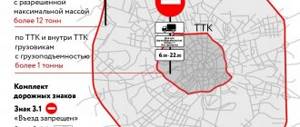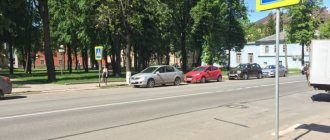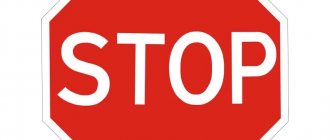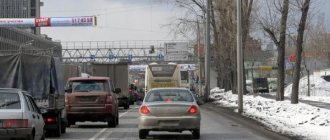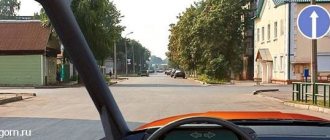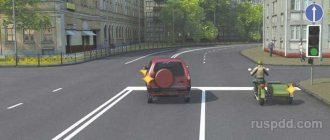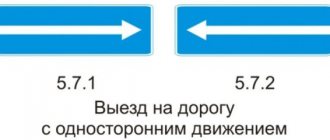Explanation of the “No Traffic” sign
Novice drivers should be reminded that the sign in question is classified as “Prohibition signs”, and in the traffic rules it is assigned No. 3.2. It is a white circle with a diameter of 70 centimeters with a red border.
Officially, it means a ban on the movement of any type of vehicle - this is exactly the wording contained in the traffic rules. It is immediately necessary to emphasize that the sign prohibits entry into a certain territory and movement through it. This is what distinguishes it from other road signs, which we will talk about later. Do not forget that the sign ends at the nearest designated intersection.
For a better understanding, here are examples of its use by road services. Most often, installation is supposed to be in front of an area in which vehicles should not be located at all. These are public gardens, pedestrian and walking areas, some courtyards, nature reserves, and so on.
Which vehicles are covered by the “No Traffic” sign?
Its effect applies to transport of any type. Drivers should be aware that they will be punished for illegal entry under sign 3.2. In this case, this is a fine, the amount of which we will discuss below.
However, like many prohibitory signs, “No Traffic” provides a fairly significant list of vehicles to which it does not apply. What exceptions are there?
Who can drive through a “No Traffic” sign?
The list of those who can safely enter the restricted area is quite large. It is established by GOST R 52289-2004. Clause 5.4.30 of this document indicates for which groups of people and vehicles “Movement is prohibited” does not apply.
Can enter:
- People living in the area within the scope of the sign.
- Drivers with disabilities of groups I or II, as well as drivers transporting persons of these groups or disabled children.
- Persons working inside the zone using personal transport.
What vehicles are allowed entry:
- Route transport, if the restricted area is located on the established route.
- Transport that serves enterprises and their employees within the “No Movement” zone.
- Transport of the state postal service, if it is indicated by a white inclined stripe on a blue background.
Naturally, the right to such travel, if necessary, needs to be confirmed, otherwise, at best, you will have an unpleasant conversation with the traffic police officers.
What documents confirm the right to move in the “No Movement” zone:
- Residents of the area covered by this sign must have a passport with the appropriate place of registration.
- Drivers who serve enterprises in this zone or deliver goods to them are required to have a permit or invoice that indicates an address within its coverage zone.
- Employees of enterprises in this zone also need something to confirm the fact of working in it. In particular, you can take your employment contract with you.
- If the driver is disabled, his vehicle must be marked with an appropriate sticker. It is necessary to have documents confirming the fact of disability.
Who can ride under the sign
Like all rules, the prohibited sign has exceptions. Firstly, the road sign can be safely ignored by the six categories of drivers named in the law:
- Disabled people of the first and second groups, as well as persons involved in their transportation.
- Employees of those bodies and organizations that are located in the protected area.
- Citizens whose place of residence is located behind the sign.
- Federal Postal Service employees on duty.
- Employees of service organizations (for example, truck drivers delivering products to a store located in a restricted area). As a rule, this is due to unloading the car.
- Drivers of vehicles traveling along an approved route (buses, trolleybuses, trams), as well as special services (ambulance, firefighters, police).
In addition, additional explanations to the “No Traffic” sign will help other groups of drivers avoid a fine in 2021. We give a few examples in the table.
What is the fine for a brick in 2021?
✅ | What is the fine for driving under a “brick” sign? In what cases can rights be revoked? Details in the article from the specialists of the website “Traffic Police Fines”
Articles of the Code of Administrative Offenses of the Russian Federation 12.16.3, 12.16.1, 12.17
“Brick” can now be found in catering establishments, shops, on the packaging of consumer goods, etc. Everywhere a red circle with a white stripe is a sign of dangerous movement and unacceptable action.
Among motorists who have had a license for a long time, it is not customary to discuss the consequences of driving under a brick. All drivers simply know that such traffic violations should be allowed as a last resort and only as a last resort. In this regard, psychologically, a fine for a brick can be equated to a fine for crossing a double solid line.
In fact, everything is both like this and not like that at the same time. The punishment for driving under a brick varies depending on the situation:
- Article 12.16.3 of the Code of Administrative Offenses of the Russian Federation. Penalty for driving against the direction on a single-lane road where a “brick” sign is installed; (fine 5,000 rubles or imprisonment from 4 to 6 months);
- Article 12.16.1 of the Code of Administrative Offenses of the Russian Federation. Fine for driving “under a brick” into the yard; (fine 500 rubles);
- Article 12.17 of the Code of Administrative Offenses of the Russian Federation. Fine for driving under a brick in bus lanes. (fine 1,500 rubles (MSK and St. Petersburg 3,000 rubles).
Note: Repeated “brick” for “oncoming traffic” per year is 5,000 rubles if the violation is recorded by a traffic police camera and imprisonment for a year if the traffic police inspector is alive.
Traffic police inspectors often confuse the penalties between various violations, united under the general name “fines for bricks.” Thus, an inattentive driver, instead of an ordinary fine of 500 rubles, can pay an amount 10 times greater. To understand what fine for a brick is provided in your case, carefully study the circumstances of a particular violation.
As such, there is no single concept of a “fine for a brick” in 2021. The brick only indicates the inadmissibility of movement in a certain direction, and the severity of the crime is determined by the specifics of the section of the road network on which sign 3.1 “entry prohibited” is installed.
The worst thing, both from the point of view of common sense and from the point of view of the law linked to this concept, is driving under a brick installed on a one-way road. Ordinary drivers speeding along such a road do not expect to encounter a car quickly approaching them. A traffic police officer who witnesses such a gross offense will certainly issue a fine of 5,000 rubles, and possibly deprive the driver of his license for up to six months).
The law is much more accepting of drivers who “sneak” under a brick into a yard or other area adjacent to the road. It is understood that one can drive in any direction in this territory; only entry into it from a certain direction is condemned. There is a fine of 500 rubles.
Fashionable innovation of the traffic police brick on the bus lane. The measure was taken to discourage drivers from even sticking their noses out onto the dedicated lane. The fine for such an offense is a decent 3,000 rubles (with a discount of 1,500 rubles), but no one takes away your rights.
A fine for a brick can easily be appealed in the courts of first instance (the courts to which the section of the road where the offense allegedly occurred is assigned).
We can say that a fine “for a brick” is generally one of the most appealed offenses in the field of traffic. Vague wording, bribe-taking, severity of responsibility and signs not installed in accordance with GOSTs lead drivers to court.
We invite you to read: Succession during the reorganization of a legal entity
To appeal a fine for a brick in court, you need to collect as much evidence as possible that the inspector’s decision is dubious. Take a photograph of the location, the condition of the sign itself, any obstacles preventing its identification, check with city planners for plans with notes on road signs tied to specific streets.
All subtypes of fines “for a brick”, that is, Articles 12.16.3, 12.16.1 and 12.17 of the Code of Administrative Offenses of the Russian Federation, starting from January 1, 2021, are subject to Federal Law N 437-FZ, dated December 22, 2014. In other words, they can be paid within 20 days from the date of receipt of the fine, with a 50% discount.
That is, the fine under Article 12.16.3 of the Code of Administrative Offenses of the Russian Federation instead of 5,000 rubles is 2,500 rubles, the fine under Article 12.16.1 of the Code of Administrative Offenses of the Russian Federation instead of 500 rubles is 250 rubles, and the fine under Article 12.17 of the Code of Administrative Offenses of the Russian Federation instead of 3,000 rubles is 1,500 rubles.
The only fine “for a brick” that cannot be paid with a discount in 2021 is the fine under Article 12.16.3.1 of the Code of Administrative Offenses of the Russian Federation - repeated, within a year, driving under a “brick” sign on a one-way road.
January 06, 2020
04 September 2019
Penalty for violation
The fine for simply driving under a “No Traffic” sign is provided for in Art. 12.16 of the Code of the Russian Federation on Administrative Offenses (CAO), and its amount is 500 rubles. But the article also outlines a more serious deviation from traffic rules, in which neglect of the prohibition creates an emergency situation. For this kind of non-compliance with the rules, increased liability is established - up to 5,000 rubles.
It is important to know! If the motorist agrees with the fine presented to him for payment and does not intend to appeal the decision of the traffic police officers, he must pay the amount specified in the resolution. We should not forget that in this case the state provides an opportunity to save on paying the fine: to do this, it is enough to be a little more efficient and meet the 20-day deadline.
Appointment procedure
Punishment can be imposed in two ways - during a stop by a traffic police inspector or after the violation is recorded on camera. In the first case, the employee of the authorized body is obliged to comply with the provisions of Federal Law No. 3 of February 7, 2011 “On the Police” and Order of the Ministry of Internal Affairs of the Russian Federation No. 664 of August 23, 2021. The procedure for imposing a fine for driving under a “No Traffic” sign in 2021 is carried out according to the following scheme:
- Noticing a violation, the traffic police inspector stops the vehicle.
- The representative of the authorized body asks the driver to demonstrate the documents reflected in paragraph 2.1.1 of the Russian Traffic Regulations.
- The citizen is informed that a violation has been committed. Photo and video results can be used as evidence.
- A protocol on an administrative offense is being drawn up.
- The driver is released. A resolution on an administrative offense will be sent by registered mail or sent through the State Services portal if the citizen has an account and it is known to the representatives of the traffic police (Article 28.6 of the Code of Administrative Offenses of the Russian Federation).
An alternative method of monitoring the actions of drivers is the use of recording cameras. The devices are designed to prevent violations, even if there are no traffic police officers nearby. If a person neglected the traffic rules and drove through a “No Traffic” sign, the punishment will be imposed according to the following scheme:
- Video recording is made at the time of the violation. The vehicle number and the fact that the vehicle was passing under a “No Traffic” sign must be recorded.
- The received information is processed. A resolution is being prepared.
- A letter demanding payment of a fine for driving under a “No Traffic” sign with photo and video evidence is sent to the citizen.
The decision is made within 15 days (Article 29.6 of the Code of Administrative Offenses of the Russian Federation). When the decision is made and documented, and the citizen has received the relevant papers, the calculation of the appeal period begins. The period is 10 days (Article 30.3 of the Code of Administrative Offenses of the Russian Federation). The administrative fine must be paid in full within 60 days (Article 32.2 of the Administrative Code of the Russian Federation). The above rules apply to penalties both from the camera and those issued when stopped by a traffic police officer.
Is it possible to challenge the punishment?
As with all cases of bringing individuals to administrative responsibility, the law (Administrative Code of the Russian Federation) provides for appeals. Accordingly, it is quite possible to cancel the fine for driving under a “No Traffic” sign in 2021.
There are two authorities to which you can apply to protect your rights:
- The head of the unit whose employee issued a fine to the driver.
- District Court. In this case, the determining factor is the place where the offense was committed, and not the place of residence of the offender.
The appeal process is also quite simple. The complaint must indicate why the violation did not occur. You can read more about the grounds for canceling decisions either in the Code of Administrative Offenses of the Russian Federation itself, or on thematic sites dedicated to this topic.
The materials that will confirm the applicant’s correctness should be attached to the application. It's important to keep two things in mind:
- The appeal procedure is absolutely free.
- It is impossible to impose a greater punishment than was already chosen when the decision was made.
Appealing a fine
If a citizen does not agree with the imposed fine for driving under a “No Traffic” sign, in 2021 you can try to appeal the decision. The corresponding right is enshrined in Article 30.1 of the Code of Administrative Offenses of the Russian Federation. Here are the authorities to which the application must be sent. If the decision was made by an inspector, you will need to provide documentation to the official’s superior, send the papers to a higher authority or to the district court at the place where the case was considered. According to a similar rule, you can appeal fines from the camera.
It is important to meet deadlines. They are given in Article 30.3 of the Code of Administrative Offenses of the Russian Federation. The complaint must be submitted within 10 days from the date of delivery or receipt of a copy of the decision.
If a period is missed, its restoration is acceptable. To do this, a petition is sent to the person authorized to consider the complaint. Typically, the period is restored if its violation occurred due to valid reasons. However, the exact list is not reflected in the legislation. The assessment of whether the reason is valid will be made by the person who has the right to consider the complaint. If the petition is granted, the citizen's appeal is accepted. If a request to restore the deadline is rejected, an appropriate determination is made.
The procedure for appealing a fine for driving under a “No Traffic” sign is carried out according to the following scheme:
- Study the resolution in detail and find grounds for appealing the fine for driving under a “No Traffic” sign. The reason for initiating the procedure may be the presence of false information in a document, the imputation of a violation that the person did not commit, and other circumstances that are unlawful.
- Prepare an evidence base. It is important to provide arguments to prove that you are right. The results of photo and video recordings and testimony of witnesses are considered as confirmation.
- File a complaint. The form of the document is not fixed in current legislation. However, when registering, you should follow the general rules of office work. The complaint must describe the reasons for which the application is made to the organization, as well as outline the requirements. The document must be supplemented with evidence.
- Submit documents to the authorized body. Submission of paper is carried out during a personal visit, by mail or through the official website of the traffic police.
- Make sure that the complaint is accepted for consideration. When papers were provided during a personal visit to the organization’s office, information about the application will be entered into the journal of incoming documentation. The person will be provided with a complaint number. When sent by mail, the date of acceptance of the application is considered the moment the item was delivered to the traffic police representative.
- Wait for the complaint to be reviewed. The process is carried out in compliance with the provisions of Articles 30.4 and 30.5 of the Code of Administrative Offenses of the Russian Federation. The answer must be provided within 10 days from the date of transfer of papers to the authorized body. The rule is relevant if the appeal is made by contacting the traffic police. When legal proceedings are initiated, the review period is extended to 2 months.
- If the applicant is not satisfied with the final verdict, you can appeal the decision again by contacting a higher authority.
An appeal against a fine for driving under a “No Traffic” sign according to the above scheme is carried out regardless of how the fine was received - during a stop by a traffic police officer or by recording the violation on a camera.
Applications for appealing a fine for driving under a “No Traffic” sign in 2021 can be found here.
Features of the sign “Trucks are prohibited”
A separate type, according to the traffic rules, is sign 3.4 “Truck traffic is prohibited.” Visually, this is a regular “No Traffic” sign, with a truck drawn inside it. In fact, this is the case that was given in the first row of the table.
An important part of the ban is the indication of the vehicle’s weight, which road workers put on the body of the car shown. So, if there is no special designation, then passage is prohibited for all cargo vehicles whose weight exceeds 3.5 tons. If the sign contains information about another mass, then you need to start from it.
As for the previously announced six exceptions, they also occur here. However, in the case of service trucks, there are additional restrictions: the absence of a trailer and a maximum weight of 26 tons. Separately, the rules stipulate cargo vehicles used for transporting people. This restriction does not apply to them.
Exceptions
The “No Traffic” sign has exceptions - “more equal than others” in this case will be:
- Russian Post cars with a characteristic identification mark (diagonal white stripe on a blue background);
- route transport;
- cars transporting disabled people ( groups 1 and 2 , no matter in what capacity - driver or passenger);
- cars of citizens permanently residing in this zone or servicing enterprises located in it.
Of course, have documents with you proving that this ban does not apply to you .
For example, invoices, certificates, passport with registration. As for disabled people, we are talking not only about documents confirming their status - that goes without saying.
itself must be equipped with appropriate signs indicating that people with disabilities are driving it.
Keep in mind that the “road guard” will most likely stop the person driving under the limiter. After which he will ask for documents and if they are not available, then a fine will be issued for driving under the “no traffic” sign.
Difference from the “No Entry” sign
This sign is a red circle with a diameter of 70 centimeters, in the middle of which there is a white rectangle (“brick”). Even the youngest drivers are familiar with it, but not everyone can explain the difference between it and the 3.2 sign.
The brick is intended to prohibit movement in a certain direction, while the previously discussed sign is intended to prohibit movement on all sides in a limited area. Simply put, “Entry prohibited” is set if driving on the road is possible, but only in one direction.
Classic examples are the installation of a “No entry” sign in front of dedicated lanes for specialized transport (public), at the beginning of one-way roads, as well as when determining the direction of travel along the territory adjacent to the road (for example, at a gas station).
For which of these signs is there a fine? If we have dealt with the “Movement prohibited” sign, then regarding the “brick” we can say that the size of the sanction is not uniform. It will depend on the specific circumstances of the offense:
- Violating the rules for driving on a one-way road is punishable by a fine of 5,000 rubles or deprivation of the right to drive a car for a period of 4 to 6 months.
- Driving into a dedicated lane without sufficient grounds will result in the payment of 1,500 rubles (3,000 rubles for Moscow and St. Petersburg).
- Improper movement in the surrounding area will cost 500 rubles.
Having familiarized yourself with all the above subtleties, each driver will be able to clearly understand how and in what direction he is allowed to move on public roads. Motorists will also have the opportunity to challenge the decision of a traffic police officer if he does not take into account the exceptions established by law or does not take into account the documents presented to him.
What is the punishment for breaking the rules?
For driving within the coverage area of sign 3.2 (provided that there is no right giving an exception), the driver will be punished under the Code of Administrative Offenses of the Russian Federation. One of two penalties is applied - either a warning or a fine in the amount of 500 rubles. If the violation is recorded for the first time, the driver is more likely to receive a warning. The driver can appeal the fine if he considers its imposition to be unlawful. The fine is small, but the more violations there are, the stricter subsequent penalties will be.
If a driver drives under a sign on a one-way road, the fine will be 5,000 rubles or deprivation of a driver’s license for 4-6 months. In such a situation, the violation will be regarded and punished as driving into the oncoming lane.
| Did not find an answer to your question? Call a lawyer! Moscow: +7 (499) 110-89-42 St. Petersburg: +7 (812) 385-56-34 Russia: +7 (499) 755-96-84 |
If a traffic police inspector stops you in the area covered by sign 3.2, you will have to justify your actions, indicate the reason for driving under the sign and, if necessary, provide the relevant documents (pass, employee ID, etc.). Even prohibitory signs may have exceptional cases. Don't be afraid of the rules: you need to learn them.
